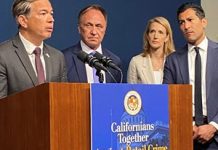In this episode of The Workplace podcast, CalChamber Executive Vice President and General Counsel Erika Frank and employment law expert Jennifer Shaw discuss how the federal Emergency Paid Sick Leave Act and the Emergency Family and Medical Leave Expansion Act interact with California laws; how to handle paid time for these new laws; the importance of written documentation; and recommendations for employers.
California Interaction with Federal Laws
Previous podcasts have discussed the Emergency Paid Sick Leave (EPSL) Act and the Emergency Family and Medical Leave Expansion Act (EFMLA), but we haven’t talked about how these new federal laws interact with California leave laws, Frank says.
On the one hand, the federal government has issued a lot of guidance on these two new leave laws while California hasn’t said much about California paid sick leave, Shaw adds. As of the time of this recording during the first week of April, California does not have an equivalent to the EPSL or the EFMLA, she says.
It is clear from federal guidance, however, that employers cannot require employees to exhaust their California paid sick leave before they use their COVID-19 sick leave, Shaw explains.
How EFMLA Differs From FMLA
Shaw outlines four points employers should know about how the EFMLA differs from the regular Family and Medical Leave Act (FMLA).
- Employees who work for a company for 30 days are eligible for the EFMLA.
- The EFMLA simply offers another reason for employees to use FMLA time. It is not an additional 12 weeks of leave. If an employee already has used their FMLA time in the last 12 months, they are not going to receive a full 12 weeks of leave.
- EFMLA is paid time. The FMLA is unpaid.
- The single purpose of EFMLA is to provide paid leave for employees who must care for a child who cannot attend childcare or school due to closures.
Employer Considerations for Paid Time
Since EFMLA is paid time, interesting issues arise dealing with integrating employees’ accrued leave balances or any wage replacement benefits an employee may be receiving from the government, Shaw says.
Pay under the EPSL will differ depending on why the employee is using the sick leave and what category the employee falls into. As a reminder, there are six categories under the EPSL, which were covered in a podcast last month.
Additionally, calculating the regular rate of pay under the EPSL is not the regular rate, but based on an average over six months, Shaw explains.
Importance of Written Documentation
One of the big differences between the EPSL and the EFMLA is the type of documentation that the employer provides to employees, the documentation the employee provides back to the employer, and the reason the employer wants the documentation, Frank says.
Written documentation will be needed to claim the tax credits the federal government is offering, Shaw says. The government understands the hardship and burden imposed on small employers to pay for time off, so a company will be reimbursed for its paid leave expenses via a tax credit. The credit will be deducted from the taxes a business owes the government.
The employer will have to prove with documentation that they are entitled to a tax credit and to do so, the employer will have to ask employees for specific information not required under the regular FMLA, Shaw explains.
A verbal request is acceptable so long as it is memorialized in writing and there is a clear agreement between employer and employee, Frank says. Documentation is important because employers are not going to memorialize the correct information if they are not asking the right questions, Shaw adds.
The CalChamber is currently drafting a form to help employers correctly fill out their tax credit forms, Frank tells listeners. FORM IS NOW AVAILABLE
Recommendations for Employers
Although many employers are used to coordinating benefits or determining which law runs concurrently, the EPSL and EFMLA are different. Frank suggests the easiest way of thinking about these two new federal laws is imagining them as two separate parallel lanes that never intersect.
Shaw recommends that employers have a separate policy for the EFMLA and the EPSL, rather than including the emergency laws in the employers’ regular FMLA policy so it is clear that these new provisions are part of the Families First Coronavirus Response Act.
The most important point, Shaw advises listeners, is to not rush. A lot of employers are feeling pressure to give their employees information the very moment they are asked a question, but employers need to be careful to take their time when formulating an answer, she emphasizes.



